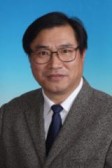Xiaofeng Kang received his Ph.D from Northwest University in 1999. Now he is a distinguished expert of Shaanxi Province Government. After completed his postdoctoral research at Chinese Academy of Sciences in 2001, he worked at Cambridge University in the UK and Texas A & M University in the U.S. during July 2001-August 2010. Dr Kang was promoted to associate professor in 1998 and professor in 2001. He has worked in the cross-cutting areas of analytical chemistry and bionanotechnology, published over 40 papers in JACS and Angew. Chem. Int. Ed. etc., has five international/ U.S. patents, and obtained many international and national awards. He also invented a single-molecule nanosensor for space exploration and has been tested in the real space flight.
Selected Publications:
[1] X.Kang*,S.Cheley,Allison C.Rice-Ficht,H.Bayley.A storable encapsulated bilayer chip containing asingle protein nanopore.J.Am.Chem.Soc.2007,129(15):4701-4705.(IF:7.885)
[2] X.Kang,S.Cheley,X.Guan and H.Bayley.Stochastic detection of enantiomers.J.Am.Chem.Soc.2006,128(33):10684-10685.(IF:7.885)
[3-1] X.Kang,L.Gu,S.Cheley and H.Bayley.Single protein pores containing mole-cular adapters at high temperature.Angew.Chem.International Edition,2005,44(10):1495-1499.(IF:10.031)
[3-2] X.Kang,L.Gu,S.Cheley and H.Bayley.Single protein pores containing mole-cular adapters at high temperature.Angew.Chem.2005,117(10):1519-1523.(IF:10.031)
[4] X.Kang,Y.Jin,G.Chen and S.Dong.In situ analysis of electropolymeration of aniline by combined electrochemistry and surface plasmon resonance.Langmuir,2002,18:1713-1718.(IF:4.009)
[5] X.Kang,Y.Jin,G.Chen and S.Dong.Surface plasmon resonance studies on the Electrochemical doping/dedoping processes of anion on polyaniline modified electrode.Langmuir,2002,18:10305-10310.(IF:4.009)
[6] Y.Jin,X.Kang,Y.Song,B.Zhang,G.Chen and S.Dong.Controlled nucleation and growth of surface confined gold nanoparticles on a(3-aminopropyl)trimethoxy silane-modified glass slide:a strategy for SPR substrates.Anal.Chem.,2001,73:2843-2849.(IF:5.287)
[7] X.Kang,Y.Jin,G.Chen and S.Dong.A novel electrochemical SPR biosensor.Electrochem.Communications,2001(3):489-493.(IF:4.186)
[8] X.Kang and J.Song.A new type of polarographic catalytic wave of organic compound—studies on the polarographic catalytic wave of medroprogesterone acetate in the presence of KIO3.Science in China(Series B-Chemistry),1999,42(5):463-470.(IF:0.615)
[9] X.Kang,W.Guo,C.Zhao and J.Song.Adsorption-parallel catalytic wave of cinnamic acid in hydrogen peroxide-tetra-n-butylammonium bromideacetate system,Science in China(Series B-Chemistry),2000,43(3):275-282.(IF:0.615)
[10] J.Song,W.Guo,X.Kang and Y.Hu.Investigation and application of polarographic catalytic wave of oxygen reduction caused by mefenamic acid.Science in China(Series B-Chemistry),1993,36(8):906-911.(IF:0.615)
Patents
[1] High Temperature Ion Channels and Pores, PCT/US2005/046649;
[2]Nanopore Sensor System, PCT/US2007/010170;
[3]High Temperature Ion Channels and Pores, 20080101988;
[4]Robust and Portable Single Protein Ion Channel Sensor Chip, 20070298511.;
[5]Method and Device of Assembling Lipid Bilayer Containing aSingle Protein Nanopore in Microfluidic Channe, TAMU14247.
